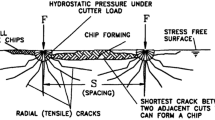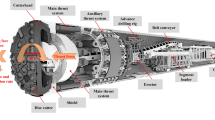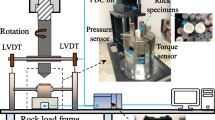Abstract
Tunnel boring machine (TBM) is a popular rock cutting machine for rapid construction of tunnels. This paper mainly dwells on the excess cutter wear and low penetration rates encountered while tunnelling through hard and abrasive rock in a head race tunnel being driven for hydel power generation. Wear prediction in disc cutters with its mechanism was reviewed. Field performance data and laboratory characterization of rock were done for analyzing the causative factors. This was followed by data analysis using a multilayer shallow neural network (MSNN) for identifying the key parameters and their influence on the output parameters (cutter wear and rate of penetration). Five major process control parameters including two machine parameters, namely, thrust and torque, one design parameter, i.e., radial position of cutter and two rock parameters namely uniaxial compressive strength (UCS) and Cerchar abrasivity index (CAI) are considered in the study. Rock type is kept constant (quartzite) to analyze the influence of the machine operating parameters on the cutter penetration rate and the cutter wear. Two different scenarios were analyzed. The correlation coefficients obtained between output and target for two cases investigated were 0.927 and 0.965, respectively. Sensitivity analysis of the input parameters on the output parameter is also carried out. For validation of the result, response surface method (RSM) was used for the analysis of historical data. Both MSNN and RSM predict the influence of key variables affecting cutter wear (CW) and rate of penetration (RoP) with a good confidence. In a given rock setting, it is possible now to fix the optimal values of Thrust and Torque to control the cutter wear while maintaining an acceptable rate of TBM penetration.
Highlights
-
TBM experiences high cutter wear and low penetration rate in hard and abrasive rock.
-
Gauge cutters get worn out more than center and face cutters due to higher rolling length and confinement.
-
Cutter wear depended more on CAI, UCS, thrust while RoP depended more on thrust and torque.
-
RSM and desirability functions identified the optimal TBM operating range of thrust and torque for lower cutter wear and higher rate of penetration.













Similar content being viewed by others
References
Agrawal AK, Murthy VMSR, Chattopadhyaya S (2019) Investigations into reliability, maintainability and availability of tunnel boring machine operating in mixed ground condition using Markov chains. Eng Fail Anal 105:477–489. https://doi.org/10.1016/j.engfailanal.2019.07.013
Agrawal AK, Chattopadhyaya S, Murthy VMSR et al (2020) A novel method of laser coating process on worn-out cutter rings of tunnel boring machine for eco-friendly reuse. Symmetry (basel) 12:1–15. https://doi.org/10.3390/sym12030471
Ahmadi S, Moosazadeh S, Hajihassani M et al (2019) Reliability, availability and maintainability analysis of the conveyor system in mechanized tunneling. Meas J Int Meas Confed 145:756–764. https://doi.org/10.1016/j.measurement.2019.06.009
Alavi Gharahbagh E, Mooney MA, Frank G et al (2013) Periodic inspection of gauge cutter wear on EPB TBMs using cone penetration testing. Tunn Undergr Sp Technol 38:279–286. https://doi.org/10.1016/j.tust.2013.07.013
Alber M, Yarali O, Dahl F et al (2014) ISRM suggested method for determining the abrasivity of rock by the cerchar abrasivity test. Rock Mech Rock Eng 47:261–266. https://doi.org/10.1007/s00603-013-0518-0
Alvarez Grima M, Bruines PA, Verhoef PNW (2000) Modeling tunnel boring machine performance by neuro-fuzzy methods. Tunn Undergr Sp Technol 15:259–269. https://doi.org/10.1016/S0886-7798(00)00055-9
Amoun S, Sharifzadeh M, Shahriar K et al (2017) Evaluation of tool wear in EPB tunneling of Tehran metro, line 7 expansion. Tunn Undergr Sp Technol 61:233–246. https://doi.org/10.1016/j.tust.2016.11.001
Armaghani DJ, Mirzaei F, Shariati M et al (2020) Hybrid ANN-based techniques in predicting cohesion of sandy-soil combined with fiber. Geomech Eng 20:191–205
Balci C, Tumac D (2012) Investigation into the effects of different rocks on rock cuttability by a V-type disc cutter. Tunn Undergr Sp Technol 30:183–193. https://doi.org/10.1016/j.tust.2012.02.018
Barton N, Shen B (2017) Risk of shear failure and extensional failure around over-stressed excavations in brittle rock. J Rock Mech Geotech Eng 9:210–225. https://doi.org/10.1016/j.jrmge.2016.11.004
Beale M, Hagan M, Demuth H (2019) MATLAB deep learning toolbox™ user’s guide: PDF documentation for release R2019a. The MathWorks, Natick
Benardos AG, Kaliampakos DC (2004) Modelling TBM performance with artificial neural networks. Tunn Undergr Sp Technol 19:597–605. https://doi.org/10.1016/j.tust.2004.02.128
Benato A, Oreste P (2015) Prediction of penetration per revolution in TBM tunneling as a function of intact rock and rock mass characteristics. Int J Rock Mech Min Sci 74:119–127. https://doi.org/10.1016/j.ijrmms.2014.12.007
Box GEP, Wilson KB (1992) On the experimental attainment of optimum conditions. Breakthroughs in statistics. Springer, Berlin, pp 270–310
Bruland A (1998) Boreability testing. Nor Soil ROCK Eng Assoc 21–27
Cardu M, Catanzaro E, Farinetti A et al (2021) Performance analysis of tunnel boring machines for rock excavation. Appl Sci. https://doi.org/10.3390/app11062794
Dogruoz C, Rostami J, Keles S (2018) Study of correlation between specific energy of cutting and physical properties of rock and prediction of excavation rate for lignite mines in Çayırhan area, Turkey. Bull Eng Geol Environ 77:533–539. https://doi.org/10.1007/s10064-017-1124-2
Gong QM, Zhao J (2009) Development of a rock mass characteristics model for TBM penetration rate prediction. Int J Rock Mech Min Sci 46:8–18. https://doi.org/10.1016/j.ijrmms.2008.03.003
Hassanpour J (2018) Development of an empirical model to estimate disc cutter wear for sedimentary and low to medium grade metamorphic rocks. Tunn Undergr Sp Technol 75:90–99. https://doi.org/10.1016/j.tust.2018.02.009
Hassanpour J, Rostami J, Tarigh Azali S, Zhao J (2014) Introduction of an empirical TBM cutter wear prediction model for pyroclastic and mafic igneous rocks; a case history of Karaj water conveyance tunnel. Iran Tunn Undergr Sp Technol 43:222–231. https://doi.org/10.1016/j.tust.2014.05.007
Hassasi S, Hassaninejad-Darzi SK, Vahid A (2021) Production of copper-graphene nanocomposite as a voltammetric sensor for determination of anti-diabetic metformin using response surface methodology. Microchem J. https://doi.org/10.1016/j.microc.2021.106877
Jung JH, Chung H, Kwon YS, Lee IM (2019) An ANN to predict ground condition ahead of tunnel face using TBM operational data. KSCE J Civ Eng 23:3200–3206. https://doi.org/10.1007/s12205-019-1460-9
Kumar Agrawal A, Chattopadhyaya S, Murthy VMSR (2021) Delineation of cutter force and cutter wear in different edge configurations of disc cutters—an analysis using discrete element method. Eng Fail Anal. https://doi.org/10.1016/j.engfailanal.2021.105727
Lan H, **a Y, Zhu Z et al (2016) Development of on-line rotational speed monitor system of TBM disc cutter. Tunn Undergr Sp Technol 57:66–75. https://doi.org/10.1016/j.tust.2016.02.023
Li XX, Li XX, Yuan D (2017) Application of an interval wear analysis method to cutting tools used in tunneling shields in soft ground. Wear 392–393:21–28. https://doi.org/10.1016/j.wear.2017.09.010
Liu B, Yang H, Karekal S (2021) Reliability analysis of TBM disc cutters under different conditions. Undergr Sp 6:142–152. https://doi.org/10.1016/j.undsp.2020.01.001
Luat N-V, Lee K, Thai D-K (2020) Application of artificial neural networks in settlement prediction of shallow foundations on sandy soils. Geomech Eng 20:385–397
Mahdevari S, Shahriar K, Yagiz S, Akbarpour Shirazi M (2014) A support vector regression model for predicting tunnel boring machine penetration rates. Int J Rock Mech Min Sci 72:214–229. https://doi.org/10.1016/j.ijrmms.2014.09.012
Miah MI, Ahmed S, Zendehboudi S, Butt S (2020) Machine learning approach to model rock strength: prediction and variable selection with aid of log data. Rock Mech Rock Eng 53:4691–4715. https://doi.org/10.1007/s00603-020-02184-2
Murthy VMSR, Chose AK, Jethwa JL (1997) Improving roadheader performance in Indian coal mines—a systems development approach and field investigations. J Mines, Met Fuels 45:66–67
Murthy VMSR, Kumar A, Sinha PK (2018) Prediction of throw in bench blasting using neural networks: an approach. Neural Comput Appl 29:143–156. https://doi.org/10.1007/s00521-016-2423-4
Oñate Salazar CG, Todaro C, Bosio F et al (2018) A new test device for the study of metal wear in conditioned granular soil used in EPB shield tunneling. Tunn Undergr Sp Technol 73:212–221. https://doi.org/10.1016/j.tust.2017.12.014
Raina AK, Murthy VMSR, Soni AK (2013) Relevance of shape of fragments on, flyrock travel distance: an insight from concrete model experiments using ANN. Electron J Geotech Eng 18:899–907
Rostami J (1997) Development of a force estimation model for rock fragmentation with disc cutters through theoretical modeling and physical measurement. Colorado School of Mines, Golden CO
Rostami J (2008) Hard rock TBM cutterhead modeling for design and performance prediction. Geomech Und Tunnelbau 1:18–28. https://doi.org/10.1002/geot.200800002
Rostami J (2016) Performance prediction of hard rock tunnel boring machines (TBMs) in difficult ground. Tunn Undergr Sp Technol 57:173–182. https://doi.org/10.1016/j.tust.2016.01.009
Rostami J, Chang SH (2017) A closer look at the design of cutterheads for hard rock tunnel-boring machines. Engineering 3:892–904. https://doi.org/10.1016/j.eng.2017.12.009
Rostami J, Ozdemir L, Nilson B (1996) Comparison between CSM and NTH hard rock TBM performance prediction models. Proc Annu Tech Meet Inst Shaft Drill Technol Las Vegas 1–10
Said KAM, Amin MAM (2015) Overview on the response surface methodology (RSM) in extraction processes. J Appl Sci Process Eng 2:8
Salimi A, Rostami J, Moormann C, Delisio A (2016) Application of non-linear regression analysis and artificial intelligence algorithms for performance prediction of hard rock TBMs. Tunn Undergr Sp Technol 58:236–246. https://doi.org/10.1016/j.tust.2016.05.009
Stachowiak GW, Batchelor AW (2000) Engineering tribology. Butterworth-Heinemann, Second
Su W, Li X, ** D et al (2020) Analysis and prediction of TBM disc cutter wear when tunneling in hard rock strata: a case study of a metro tunnel excavation in Shenzhen. China Wear 446–447:203190. https://doi.org/10.1016/j.wear.2020.203190
Trivedi R, Singh TN, Raina AK (2014) Prediction of blast-induced flyrock in Indian limestone mines using neural networks. J Rock Mech Geotech Eng 6:447–454. https://doi.org/10.1016/j.jrmge.2014.07.003
Villeneuve MC (2017) Hard rock tunnel boring machine penetration test as an indicator of chip** process efficiency. J Rock Mech Geotech Eng 9:611–622. https://doi.org/10.1016/j.jrmge.2016.12.008
Wang L, Kang Y, Cai Z et al (2012) The energy method to predict disc cutter wear extent for hard rock TBMs. Tunn Undergr Sp Technol 28:183–191. https://doi.org/10.1016/j.tust.2011.11.001
Wang L, Kang Y, Zhao X, Zhang Q (2015) Disc cutter wear prediction for a hard rock TBM cutterhead based on energy analysis. Tunn Undergr Sp Technol 50:324–333. https://doi.org/10.1016/j.tust.2015.08.003
Wang L, Li H, Zhao X, Zhang Q (2017) Development of a prediction model for the wear evolution of disc cutters on rock TBM cutterhead. Tunn Undergr Sp Technol 67:147–157. https://doi.org/10.1016/j.tust.2017.05.003
**a Y, Zhang K, Liu J (2015) Design optimization of TBM disc cutters for different geological conditions. World J Eng Technol 03:218–231. https://doi.org/10.4236/wjet.2015.34023
Yagiz S, Karahan H (2011) Prediction of hard rock TBM penetration rate using particle swarm optimization. Int J Rock Mech Min Sci 48:427–433. https://doi.org/10.1016/j.ijrmms.2011.02.013
Yang Y, Hong K, Sun Z et al (2018) The derivation and validation of TBM disc cutter wear prediction model. Geotech Geol Eng 36:3391–3398. https://doi.org/10.1007/s10706-018-0540-9
Zare S, Bruland A (2013) Applications of NTNU/SINTEF drillability indices in hard rock tunneling. Rock Mech Rock Eng 46:179–187. https://doi.org/10.1007/s00603-012-0253-y
Zhang X, Lin L, **a Y et al (2018) Experimental study on wear of TBM disc cutter rings with different kinds of hardness. Tunn Undergr Sp Technol 82:346–357. https://doi.org/10.1016/j.tust.2018.08.050
Zhang Z, Aqeel M, Li C, Sun F (2019) Theoretical prediction of wear of disc cutters in tunnel boring machine and its application. J Rock Mech Geotech Eng 11:111–120. https://doi.org/10.1016/j.jrmge.2018.05.006
Zhang Z, Zhang K, Dong W (2021) Experimental investigation on the influence factors on TBM cutter wear based on composite abrasion test. Rock Mech Rock Eng. https://doi.org/10.1007/s00603-021-02621-w
Zhao Z, Gong Q, Zhang Y, Zhao J (2007) Prediction model of tunnel boring machine performance by ensemble neural networks. Geomech Geoengin 2:123–128. https://doi.org/10.1080/17486020701377140
Acknowledgements
Authors are grateful to CPRI for funding the research project (Project no. CPRI/2016-17/492/ME) and NHPC Ltd. for permitting site investigations and providing needful support. Support of Gaurav Kumar Srivastava, Biswaraj Dash, Ch. Srihari, Manish Kumar, research scholars and Shri R.K.Das Technical Superintendent, Rock Excavation Laboratory, IIT (ISM), Department of Mining Engineering, are thankfully acknowledged. The views expressed are of authors and have their domain of interpretation.
Author information
Authors and Affiliations
Corresponding author
Ethics declarations
Conflict of interest
The authors declare they have no conflict of interest.
Additional information
Publisher's Note
Springer Nature remains neutral with regard to jurisdictional claims in published maps and institutional affiliations.
Appendix
Appendix
See Table 10
Final Equation in Terms of Coded Factors.
CW0.88 = + 11.45 + 0.3186 A−1.2 B−0.1208 C – 0.7552 D−7.44 E[1] – 1.22 E[2] + 2.90 E[3] + 0.5214 AE[1] + 0.2518 AE[2] – 0.3511 AE[3] + 1.36 BD + 1.54 CE[1] – 0.1928 CE[2] −0.7820 CE[3] + 0.5448 B2 + 0.3572 D2.
For given levels of each element, the equation in terms of coded factors can be used to make predictions about the response. The high levels of the factors are coded as + 1 and the low levels of the factors are coded as -1 by default. By comparing the factor coefficients, the coded equation can be used to determine the relative impact of the components.
Final Equation in Terms of Actual Factors are as follows:
CW0.88 = CAI Level 1 of D + 24.58370 + 0.000143 * Thrust—0.012560 * Torque + 0.000925 * RPC—0.137452 * UCS + 0.000043 * Torque * UCS + 1.11186E-06 * Torque2 + 0.000176 * UCS2.
CW0.88 = CAI Level 2 of D + 33.28259 + 0.000097 * Thrust-0.012560 * Torque—0.000205 * RPC—0.137452 * UCS + 0.000043 * Torque * UCS + 1.11186E-06 * Torque2 + 0.000176 * UCS2.
CW0.88 = CAI Level 3 of D + 38.94808—5.55066E-06 * Thrust—0.012560 * Torque—0.000589 * RPC—0.137452 * UCS + 0.000043 * Torque * UCS + 1.11186E-06 * Torque2 + 0.000176 * UCS2.
CW0.88 = CAI Level 4 of D + 41.62735—0.000018 * Thrust—0.012560 * Torque -0.000447 * RPC—0.137452 * UCS + 0.000043 * Torque * UCS + 1.11186E-06 * Torque2 + 0.000176 * UCS2.
See Table 11
Final Equation in Terms of Coded Factors are as follows:
√RoP = + 1.70—0.1640 * A + 0.1412 * B + 0.0346 * C—0.5768 * D—0.1504 * E[1] + 0.0483 * E[2] + 0.0597 * E[3]—0.2256 * AD + 0.1967 * BD + 0.1655 * CE[1]—0.0117 * CE[2]—0.0560 * CE[3]—0.1213 * B2 + 0.2457 * D2.
Final Equation in Terms of Actual Factors.
√RoP = CAI Level 1 of D + 8.17090 + 0.000139 * Thrust—0.000422 * Torque + 0.000131 * RPC—0.060769 * UCS—8.54739E-07 * Thrust * UCS + 6.24570E-06 * Torque * UCS—2.47632E-07 * Torque2 + 0.000121 * UCS2.
√RoP = CAI Level 2 of D + 8.58540 + 0.000139 * Thrust—0.000422 * Torque + 0.000015 * RPC—0.060769 * UCS—8.54739E-07 * Thrust * UCS + 6.24570E-06 * Torque * UCS—2.47632E-07 * Torque2 + 0.000121 * UCS2.
√RoP = CAI Level 3 of D + 8.65081 + 0.000139 * Thrust—0.000422 * Torque -0.000014 * RPC—0.060769 * UCS—8.54739E-07 * Thrust * UCS + 6.24570E-06 * Torque * UCS—2.47632E-07 * Torque2 + 0.000121 * UCS2.
√RoP = CAI Level 4 of D + 8.68444 + 0.000139 * Thrust—0.000422 * Torque -0.000041 * RPC—0.060769 * UCS—8.54739E-07 * Thrust * UCS + 6.24570E-06 * Torque * UCS—2.47632E-07 * Torque2 + 0.000121 * UCS2.
Rights and permissions
About this article
Cite this article
Agrawal, A.K., Murthy, V.M.S.R., Chattopadhyaya, S. et al. Prediction of TBM Disc Cutter Wear and Penetration Rate in Tunneling Through Hard and Abrasive Rock Using Multi-layer Shallow Neural Network and Response Surface Methods. Rock Mech Rock Eng 55, 3489–3506 (2022). https://doi.org/10.1007/s00603-022-02834-7
Received:
Accepted:
Published:
Issue Date:
DOI: https://doi.org/10.1007/s00603-022-02834-7




